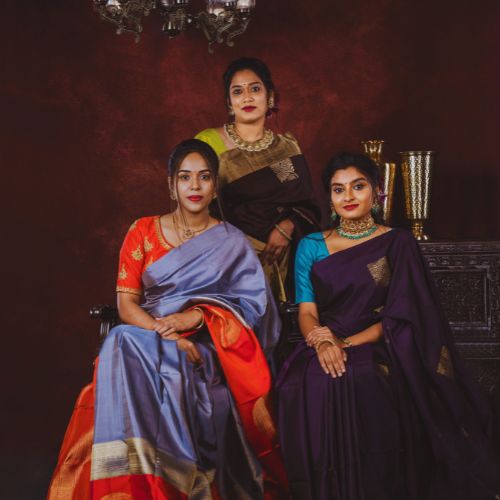History and Evolution of the Saree
Sarees are a celebration of culture, grace, and tradition. From ancient drapes to modern-day fashion staples, sarees have a fascinating history that continues to captivate fashion enthusiasts around the world. In this blog, we will unravel the journey of the saree—from its humble beginnings to its glamorous contemporary forms, and understand why it remains an enduring symbol of elegance.
What is a Saree?
The saree, known as "sari" in some regions, is a classic piece for women that drapes gracefully around the body. Originating from the Sanskrit word “Saadi,” meaning "a strip of cloth," the saree is a long piece of fabric, usually between 6 to 9 yards in length, worn in a variety of styles. Each saree reflects its unique cultural and regional roots through its colors, patterns, and weaving techniques. The beauty of a saree lies in its ability to adapt to different occasions, whether it’s a wedding, a formal event, or a casual gathering.
A Glimpse into the History of Saree
The saree’s history stretches back thousands of years. Its origins can be traced to the Indus Valley Civilization, around 2800 BCE, where early weavers used dyes such as indigo, lac, and turmeric. These ancient techniques laid the foundation for the intricate patterns and colors we see in sarees today.
During the Mughal era (16th to 19th centuries), sarees evolved significantly. The Mughals, known for their love of opulence, introduced elaborate embroidery techniques like zardozi and kamdani. This period saw the saree being embraced by both royalty and commoners, marking its transition from a traditional garment to a symbol of everyday elegance.
Interestingly, sarees were once worn by both men and women. It was only over time that they became predominantly a women'swear. The Victorian era, under British rule, brought about the introduction of blouses (cholis) for sarees, as it became considered improper to expose arms and shoulders. This shift was embraced across India, making blouses an integral part of saree-wearing.
The Evolution of Saree
The saree has undergone remarkable transformations over the centuries:
- British Influence: The British Raj introduced new fabrics like chiffon, net, and georgette, which added comfort and breathability to sarees, making them suitable for various climates.
- Dyeing and Printing Techniques: The advent of synthetic dyes and printing techniques in the 19th and 20th centuries allowed for vibrant colors and intricate patterns, including temple motifs, floral prints, and nature-inspired designs.
- Modern Innovations: In contemporary fashion, sarees have been reinvented with innovative draping styles and modern fabrics. Designers have embraced the saree’s adaptability, creating pieces that range from traditional to avant-garde, making it a versatile garment for every occasion.
The Cultural Significance of Saree
The saree is a symbol of grace, tradition, and cultural heritage in India. Each saree type, from the luxurious Banarasi to the vibrant Kanjivaram, tells a story of its region and the craftsmanship involved. Wearing a saree during festivals, weddings, and ceremonies highlights its importance in celebrating significant moments and preserving cultural identity.
The saree’s ability to seamlessly blend tradition with modernity ensures its place as a timeless garment. Whether it’s the classic six-yard drape or the elaborate nine-yard madisar, the saree continues to be a cherished and essential part of a woman’s wardrobe.
Conclusion
From its origins in the Indus Valley to its status as a global fashion icon, the saree embodies a rich tapestry of history, culture, and style. Its evolution over the centuries reflects the dynamic nature of Indian textile traditions and its remarkable adaptability. The next time you drape yourself in a saree, remember you’re not just wearing a piece of clothing—you’re embracing a legacy that spans millennia. If you’re looking to add an enchanting and sophisticated saree to your collection, explore options in JP Silks that offer comfort, quality, and timeless elegance. The saree is truly a symbol of enduring grace and charm—an essential part of every woman’s wardrobe.






